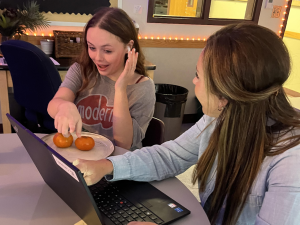The Future of School Funding
Many schools have started working with local companies in exchange for advertising the company’s services. This allows the school to increase funding, without local taxes increasing.
May 9, 2018
Recently, schools across the United States have started to look toward outside support in the form of private donations and local business sponsorship to increase education funding. This has become an increasingly popular alternative during the last few years due to rising school budgets nationwide.
In the state of New Hampshire, public education costs on average $13,700 per student yearly. According to Gretchen McKay, about one-third of school funding has regressed within the past few years. This is because schools spend increasingly more money on internal and external school extensions in the form of new technology, supplies, programs, staff salary increases, or staff/faculty additions. It has becoming increasingly difficult to find money within the budget for new updates for school districts nationwide without raising taxes, which other alternatives, such as fundraising, cannot sufficiently cover. The excess money not just desired for schools to grow, but deemed necessities for schools to operate i.e school lunches, electricity costs, heating bills, transportation, or existing equipment cost be it for teachers or extracurriculars. “The state used to give more to schools, but they are pulling away from that, a process known as ‘devolution’ which pushes it down onto the local level and puts the burden on the taxpayers, which is the issue we are having right now,” said Trevor Duval, a history and government teacher at Hollis-Brookline High School.
According to Jim Hull, the Senior Policy Analyst for the Center for Public Education for the National School Board Association, “The average district receives about 44 percent of its funds from the local government, 47 percent from the state government, and about 9 percent from the federal government”. The 44 percent of funds coming from the local government is collected through both property tax. In order to fund public education without raising taxes, schools all over the nation have turned to private funding. “In the state of New Hampshire, funding from schools comes from taxes and it’s not enough, it’s a strain on the taxpayers, so there needs to be more money coming in from somewhere,” said Richard Winslow, a guidance counselor at HBHS.
But the somewhere that Mr. Winslow references is the issue at hand. Naturally, there are various ways for schools to gain funding outside of taxation on the local level, in order to combat budget increases. For specific programs, there are federal grants available, as well as many donation services for schools in need such as the Bill and Melinda Gates Foundation. Additionally, there are often private donations from corporate and local business provided to schools for additions and programs that involve particular fields of study.
The idea behind private donations from businesses stems from a mutually beneficial relationship between the school and the company. Essentially the matter of school funding becomes an exchange, so the term “donation” is nearly incorrect since business aren’t committing acts of charity, they are receiving benefit from investing in schools. By adding to the school’s curriculum or programs, they are allowed to provide services that, in their eyes, are necessary for the students. But the question is who is allowed to judge what is necessary for students to learn.
Through providing technology, supplies, and alternative opportunities for students, donors, specifically businesses, often look to advertise. The partnership between public schools and private businesses often allows the donating businesses to implement company logos and banners throughout the school, giving companies another space in which to reach both young and old in a place that was before not possible. Additionally, school curriculums receive input from companies which can be seen as allowing students to get some sort of practical experience and possible opportunity under a specific field. “[Local business] is a great way to get outside funding. With the way the world is today we need to find ways to open up… to be involved in some way be a part of the curriculum then you are training kids in a way that the employers want. How is that wrong? You get real hands-on experience,” adds Winslow.
Mr. Winslow makes a compelling argument about the ways in which small business and school agendas can align and receive equal benefit. The school receives necessary funding, as well as program expansion and field opportunities, so that students can get real hands-on, practical experience with employers. In turn the cooperating business likely receives a broad spectrum of results, from the obvious advertising space to partnership with the student body.
However, everything comes with strings attached, and giving a company power and say in public school curriculum is a controversial subject (since company agendas do not always work towards the goal of public education). “It’s a question of how does it fit in with the politics of the school? And if you do except a donation then how do you let that donator have a say or do they have a say? And if they do have a say is their vision conflicting with the vision of the school?” said Winslow.
These questions are difficult ones to answer because, realistically, there is only so much one can tax a population base towards any single thing. Everyone wants a beneficial school system, but at some point the limit is reached in terms of what the community can pay for. At some point funding has to come from somewhere that is not just the public, but how should that be integrated so that there is a beneficial relationship on both ends? Mr. Duval stated: “Do we need more funding? Yes. Where does it come from? If anyone could come up with an answer that, they would be a very wealthy individual.” There are various solutions outside of taxation, but everything comes at some sort of cost and it boils down to what a school system and citizens are willing to compromise to pay for their wants and needs. Funding will always to be a two sided issue. So, what needs to be changed to solve a problem that seems to lack a solution? Duval thinks, “Maybe it’s not how we change funding, but how we change mindsets about funding and what our priorities need to be as a community. [Private philanthropy] is always a solution, but there are only so many times where you can count on the charity of others; at what point should we not expect the charity of other but be reliant on ourselves, as a community, as a family, to take care of our own needs?” said Duval.
There is only one thing for certain, in a sea of possible solutions towards an on-going funding issue throughout the nation, there is no immediate remedy. As long as education costs continue to rise and public schools do not cease their efforts to improve, only time will tell what schools like HBHS do next.














